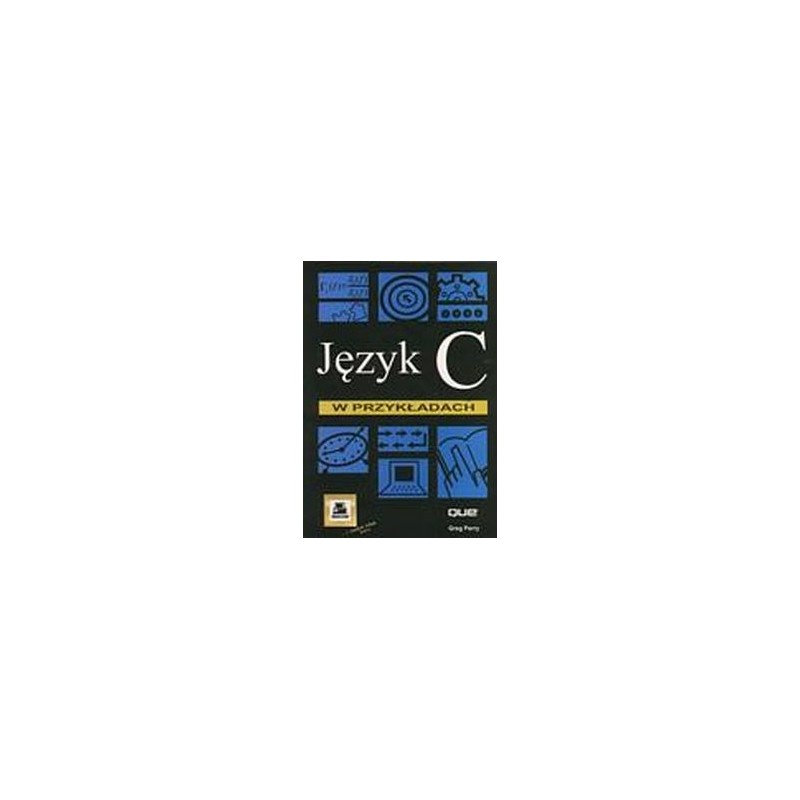- Out-of-Stock



C language in examples; Greg Perry
Author: Greg Perry
ISBN: 83-7279-064-7
Release date: 2000
Format: B5, s. 504
Binding: soft
Publisher: Mikom
About the book
The task of the book is to teach beginners and intermediate users of the C language. The individual chapters contain not only valuable tips, comments, warnings and references to other necessary information, but also summaries. The last chapter presents a fully functioning program illustrating all issues described in the book.
Part I. Welcome to C
Chapter 1. What is the language of C
C as the basis for other programming languages
History of C language
What C is different from other programming languages
The process of writing a program in C language
Starting the program
Error handling
Chapter 2. Analysis of programs written in C language
Program analysis
The form of the program written in C language
Analysis of a simple program
Chapter 3. Variables and constants
Variables
Assigning variable values
literals
Chapter 4. Introduction to tables
Introduction to tables
Character tables and strings
Chapter 5. The preprocessor directive
What are the preprocessor directives?
#Include directive
#Define directive
Chapter 6. Entry and exit
The printf () function
Printing of strings
Defining conversion characters
Modifiers for conversion characters
The printed values must correspond to the control chain used
Use the scanf () function to enter data
Part II. C language operators
Chapter 7. Operators and precedence rules
The basic mathematical operators of the C language
Unary operators
Dividing and sharing modulo
Rules of priority
Using parentheses
Assignment instructions
Using data of various types in calculations
Chapter 8. Relational and logical operators
Definition of relational operators
If statement
Else statement
Chapter 9. Other C language operators
Definitions of logical operators
Logic operators and their use
Logical efficiency of C language
Logic operators and precedence rules
Conditional operator
Increase and decrease operators
Sizeof operator
Comma operator
Part III. Controlling program execution
Chapter 10. While looping
The while statement
Do-loops
Comparison of the if statement with the while loop
The exit () function and the break statement
Counters and value counting
Counting values
Chapter 11. Forward loop
Instructions for
Loop concept
Nested for loops
Chapter 12. Controlling the course of the program
Break and for instructions
Continue statement
Switch statement
Goto instructions
Part IV. Variable reach and structural programming
Chapter 13. Introduction to the C language function
Basics of functions
Dividing problems into smaller fragments
More about functions
Calling and returning functions
Chapter 14. Range of variables
Global and local variables
Automatic and static variables
Three issues related to parameter assignment
Chapter 15. Passing values between functions
Transmission by value (by copy)
Forwarding by address
Chapter 16. Returning values by functions
The values returned by functions
Function prototypes
Part V. Standard input, output and internal functions
Chapter 17. Signal and associated input / output operations
with a specific device
Input / output in the form of a stream of characters
Standard devices
Printing of formatted data
Functions of character input and output operations
Chapter 18. Functions that operate on character strings and numeric functions
Functions operating on characters
Functions that work on character strings
Numeric functions
Part VI. Creating blocks in the program
Chapter 19. Working with arrays
Basic information about boards
Initiating tables
Searching tables
Searching for values in arrays
Sorting tables
Advanced methods of referring to arrays
Chapter 20. Appealing to data using indicators
Introduction to indicator variables
Indicator boards
Chapter 21. Use of indicators
Indicators as table names
Benefits resulting from the use of indicators
Applying indicators for character variables
Indicator arithmetic
Arrays with strings
Part VII. Advanced programming in C
Chapter 22. Introduction to structures
Introduction to structures
Defining structures
Initializing data in the structure
Nested structures
Chapter 23. Arrays of structures
Declaring structure tables
The use of tables as elements of structures
Using malloc () and free () to dynamically allocate memory
Chapter 24. Simple file processing
What is the role of the disk
Distributes access to files on the disk
The concept of a sequential file
Opening and closing of sequential files
Saving to a file
Data printing on the printer
Attaching data to a file
Reading data from a file
Direct access file records
Opening files with direct access
The fseek () function
Other useful input and output functions
Chapter 25. Summary
Description of the program
Program
What's next
Part VIII. Additives
Appendix A. Binary and hexadecimal memory addressing Computer memory
The order of bits
Binary numbers (binary)
Bylal arithmetic
Negative binary numbers
Hexadecimal numbers
Why learn hexadecimal numbers
What relationship exists between binary notation and memory addressing and C language
Appendix B. Table of priorities
Appendix C. ASCII character table
No product available!
No product available!
No product available!
No product available!
No product available!
Dispensing needle for precise application of glue, flux with an internal diameter of 0.51mm and an external diameter of 0.8mm.
No product available!
No product available!
No product available!
Power HD High-Speed Digital Sub-Micro Servo DSP33
No product available!
The ESP32-P4-NANO-KIT-D is a complete platform for designing HMI and IoT systems. It offers high performance, a rich set of interfaces, and support for Wi-Fi 6 and Bluetooth 5. The kit includes a 10.1" touchscreen, camera, and speaker, enabling rapid prototyping of interactive devices.
No product available!
No product available!
AVT kit for self-assembly of an 8-channel thermometer with alarm and LCD display. AVT5489 B
No product available!
No product available!
No product available!
Assembled 4-channel infrared switch controlled by any IR remote control. AVT1815 C
No product available!
No product available!

C language in examples; Greg Perry
